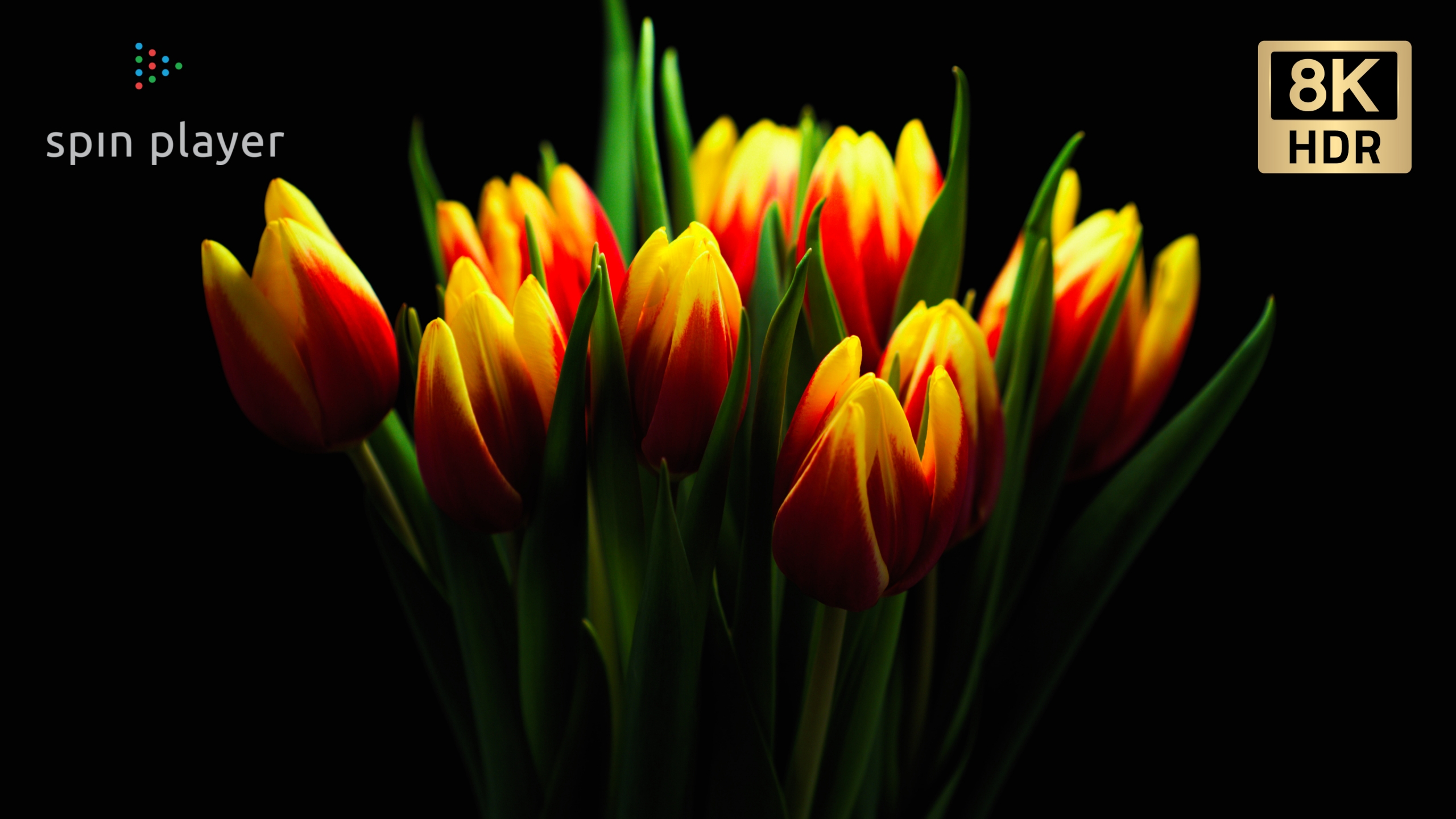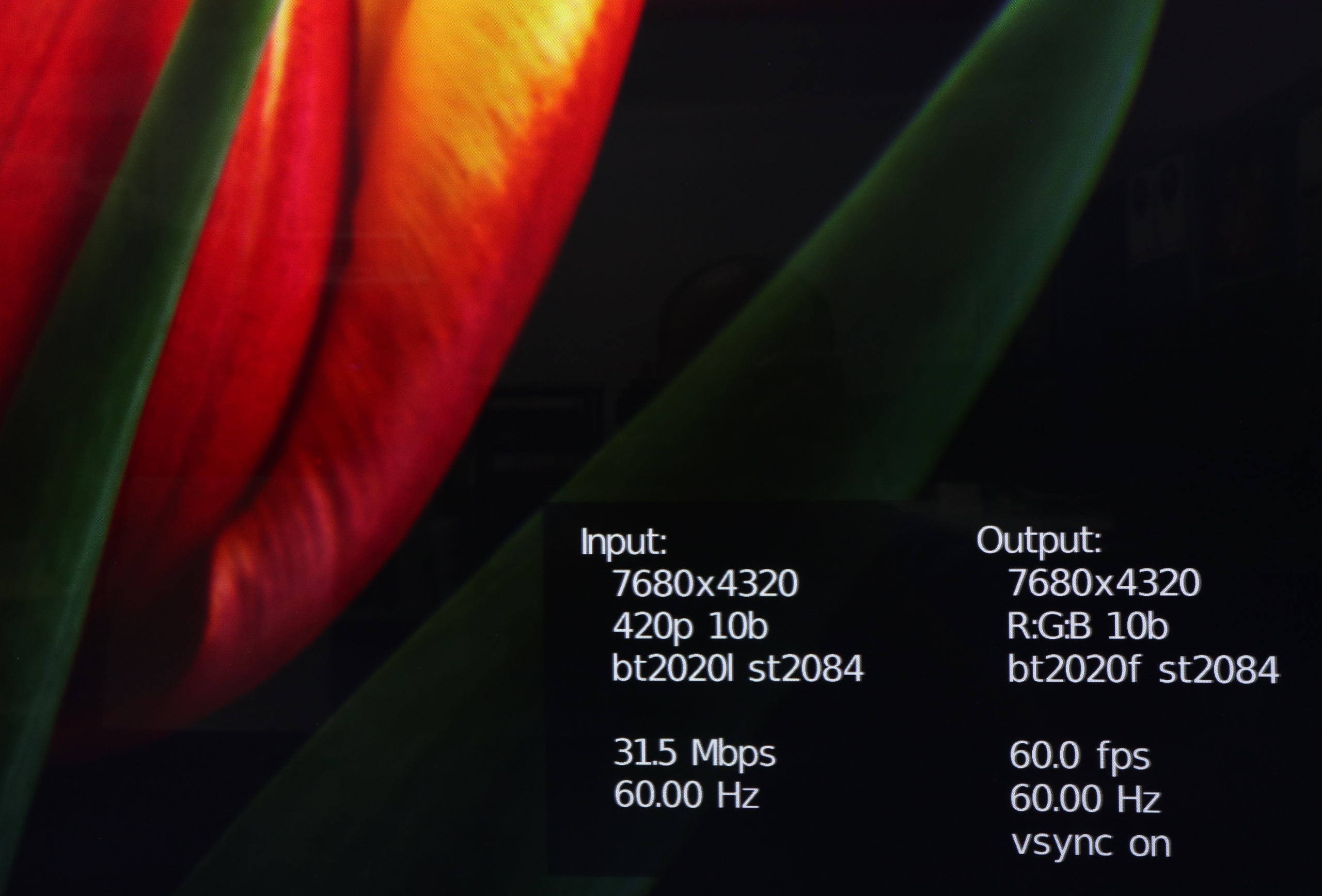NEWS
TECH BLOG / July 8, 2021
8K HDR Playback Using Spin Digital’s Media Player
By Mauricio Alvarez-Mesa, PhD, Sergio Sanz-Rodríguez, PhD — In this technical blog we discuss how to support High Dynamic Range (HDR) for 8K video. We present the options available for 8K HDR playback and their capabilities and limitations, and we show how Spin Digital’s media player (Spin Player) can meet the requirements of 8K HDR applications using a software solution based on the latest generation of computing systems (CPUs and GPUs) and AV interfaces (HDMI 2.1).
8K HDR: More than More Pixels
The 8K video format is much more than higher resolution. It is designed to provide a stronger sensation of reality and a greater immersive experience. In order to achieve this, the 8K format combines higher pixel counts (four times higher than 4K UHD), with High Dynamic Range (HDR), Wide Color Gamut (WGC), and potentially High Frame Rates (HFR).
Therefore, an 8K media player has to support, at least, 8K resolution, 50 or 60 fps, 10-bit, some of the common HDR and WCG formats, and optionally HFR. The requirements of 8K professional and distribution 8K formats are summarized in Table 1.
| Format properties | 8K professional format | 8K distribution format |
|---|---|---|
| Resolutions [pixels] | 7680x4320 | 7680x4320 |
| Frame rate [fps] | 50/60 | 50/60 |
| HFR [fps] | 100/120 (optional) | 100/120 (optional) |
| Color sampling | 4:2:2, 4:4:4, RGB | 4:2:0 |
| Bit depth | 12-bit | 10-bit |
| HDR transfer function | PQ, HLG | PQ, HLG |
| Color Gamut | BT.2020 | BT.2020 |
| Video codec and profile | HEVC Range Extensions | HEVC Main 10 |
Table 1: 8K format description
HDR Formats and Standards for 8K Video
There are two main formats being used for HDR: PQ (Perceptual Quantizer) defined by the SMPTE ST2084 standard (and also in BT.2100), and HLG (Hybrid Log Gamma) defined by the ARIB STD-B67 standard (and also in BT.2100).
If static metadata is added to PQ, the format is called HDR10. Other HDR formats support dynamic metadata such as Dolby Vision, HDR10+, and SL-HDR2. The following table shows the main properties of these formats.
| Format properties | PQ (10-bit) | HLG (10-bit) | HDR10 |
|---|---|---|---|
| Transfer function | PQ (SMPTE ST2084) | HLG (ARIB STD-B67) | PQ (SMPTE ST2084) |
| Bit depth | 10-bit | 10-bit | 10-bit |
| Color primaries | BT.2020 (BT.2100) | BT.2020 (BT.2100) | BT.2020 (BT.2100) |
| Static metadata | none | none | - Color volume (SMPTE ST2086) - MaxFALL - MaxCLL |
| Dynamic metadata | none | none | none |
Table 2 : HDR formats
8K HDR Playback
When the media player receives an 8K HEVC or VVC bitstream, the following information is required for appropriate HDR playback:
- Transfer function: PQ, HLG
- Colorimetry: BT.2020 (BT.2100)
- Matrix coefficients: BT.2020 PQ, BT.2020 HLG
- Color model: YCbCr, RGB
- Video range: full, limited
- HDR static metadata: Color volume, MaxFALL, MaxCLL
The static HDR metadata can be transported in a Supplementary Enhancement Information (SEI) message together with the HEVC or VVC bitstream. The transfer function, colorimetry, and matrix coefficients can be transported using the Video Usability Information (VUI) messages of HEVC and VVC.
The decoder decompresses the bitstream and passes the decoded video frames together with the metadata to the video renderer. The video renderer produces the final rendered frame that is sent over the digital AV interface to the display. In addition, in a PC-based system, the video rendering engine has to perform composition with other graphical sources. Figure 1 illustrates the flow chain of a typical software media player with a GPU-based renderer.
 Figure 1: Flow chain of an 8K media player for HDR with GPU rendering
Figure 1: Flow chain of an 8K media player for HDR with GPU rendering
Currently, when using Windows 10/11 PC systems only the HDR10 (PQ) format is supported for HDR playback. HDR formats with dynamic metadata are not supported, and content based on transfer functions different than PQ, i.e. HLG, has to be converted to SDR using tone (and gamut) mapping. The table below shows the capabilities of Spin Player when using GPU rendering on Windows 10.
| GPU-based rendering for PQ and HDR10 | GPU-based rendering for HLG | |
|---|---|---|
| Content format | PQ / HDR10 BT.2020 (BT.2100) | HLG BT.2020 (BT.2100) |
| Decoder | HEVC | HEVC |
| Metadata carriage | SEI + VUI | SEI + VUI |
| Renderer | PQ / HDR10 BT.2020 (BT.2100) | HLG-to-SDR tone mapping BT.2020-to-BT.709 gamut mapping |
| Windows 10 compositor | PQ / HDR10 BT.2020 (BT.2100) | SDR BT.709 |
| AV interface | PQ / HDR10 HDMI 2.1 | SDR/BT.709 1x HDMI 2.1 or 4x HDMI 2.0 |
Table 3: HDR support for PQ and HLG on Windows 10 PC systems using Spin Player
The figure below shows the player flow chain when using HDR10 (PQ). The entire chain is supported in HDR10 (PQ) and therefore conversions such as tone mapping are not needed.
 Figure 2: Flow chain of an 8K media player for HDR with PQ format
Figure 2: Flow chain of an 8K media player for HDR with PQ format
8K HDR with HDMI 2.1 Interface
Until relatively recently, 8K playback using Spin Digital’s media player or other software players required an AV interface with four cable connections. The most common interface was four DisplayPort outputs that required, in turn, to be converted to four HDMI 2.0 connections before they could be connected to the 8K TV. This 2×2 HDMI 2.0 format was supported by early 8K TVs. Due to some limitations of GPU drivers this format did not not support any HDR format.
With the launch of the new generation of GPUs and 8K TVs supporting the latest version of the HDMI interface (2.1), 8K playback is not only simpler, since only one cable is needed to connect to the TV, but is also possible to play 8K with HDR.
HDMI 2.1 is the latest version of the HDMI format for transporting audiovisual signals to TVs. Unlike its predecessor (HDMI 2.0) that accepts signals up to 4Kp60, this new version supports higher resolutions and frames rates including 4Kp120 and 8Kp60. In addition, HDMI 2.1 supports static and dynamic HDR metadata to adapt the dynamic range of the content on a scene basis or even a frame basis to the TV HDR capabilities.
Which Devices Support HDMI 2.1?
The NVIDIA GeForce RTX 30 Series , AMD Radeon 6000 Series, and Intel Arc A Series GPUs include HDMI 2.1 output with 8K capabilities. Most recent 8K TVs support HDMI 2.1 input.
What are the Advantages of HDMI 2.1 for 8K Playback?
The HDMI 2.1 format offers several advantages for 8K playback with respect to the previous system based on HDMI 2.0:
- Simpler 8K playback system: Only one cable, without additional converters, is needed to connect the GPU to the 8K TV. In addition the configuration for 8K playback is much simpler (no need for complex Nvidia Mosaic and AMD Eyefinity multi monitor setups).
- Support for HDR: The new interface is capable of transporting HDR and HDR-related metadata together with the 8K signal.
- Greater choice of TVs: Most 8K TVs on the market support HDMI 2.1.
 Figure 3. 8K HDR playback with Spin Digital’s media player (Spin Player)
Figure 3. 8K HDR playback with Spin Digital’s media player (Spin Player)
System Validation for 8Kp60 Playback
Spin Digital’s media player has been validated successfully for 8Kp60 HDR playback using the HDMI 2.1 interface. The recommended playback system for 8K is described in the technical brochures of the different players editions: Spin Player HEVC and Spin Player VVC.
8K HDR playback with HDMI 2.1 has been validated using a Sony Bravia XR Z9J 8K HDR TV (XR-75Z9J). 8K content in PQ format including static HDR10 metadata was encoded in HEVC using Spin Digital file encoder (Spin Enc File). Spin Player decoded the HEVC stream and performed rendering in HDR10 (PQ), as shown in the figure below. Windows 10 was configured for HDR10, and the GPU was configured for 8Kp60, 4:2:0, 10-bit format.
 Figure 4: Spin Player HEVC screenshot when playing 8K PQ encoded content on an 8K TV
Figure 4: Spin Player HEVC screenshot when playing 8K PQ encoded content on an 8K TV
Conclusion
8K HDR playback is now possible using optimized software media players. HEVC and VVC decoding with HDR metadata can be performed on a desktop CPU, and HDR rendering can be performed using a recent GPU together with an OS compositor that supports HDR. Latest GPUs also offer support for the HDMI 2.1 interface that allows for single cable connection and HDR for 8Kp60 content. As a result, an end-to-end HDR experience is possible. Currently Windows 10/11 based systems only support the HDR10 format. Other HDR formats such as HLG require tone and gamut mapping. HDR support in PC systems and HDR formats in general are still evolving. In the future we will analyze the support for dynamic HDR formats such as Dolby Vision, HDR10+, and others.
References
- ST 2084:2014 – SMPTE Standard – High Dynamic Range Electro-Optical Transfer Function of Mastering Reference Displays, Aug. 2014.
- ARIB STD-B67. Parameter Values for the Hybrid Log-Gamma (HLG) High Dynamic Range Television (HDR-TV) System for Programme Production. http://www.arib.or.jp/english/html/overview/doc/2-STD-B67v2_0.pdf
- ST 2086:2018 – SMPTE Standard – Mastering Display Color Volume Metadata Supporting High Luminance and Wide Color Gamut Images, April 2018.
- Recommendation ITU-R BT.2020, “Parameter values for ultra-high definition television systems for production and international programme exchange”
- Recommendation ITU-R BT.2100, “Image parameter values for high dynamic range television or use in production and international programme exchange”, June 2017,
http://www.itu.int/rec/R-REC-BT.2100 - Report ITU-R BT.2390-2, “High dynamic range television for production and international programme exchange”, https://www.itu.int/pub/R-REP-BT.2390-2016
- HDMI Specification Technology Overview. https://www.hdmi.org/spec/hdmi2_1
- Display requirements for HDR video in Windows. https://support.microsoft.com/en-us/windows/display-requirements-for-hdr-video-in-windows-192f362e-1245-e14d-3d3f-4b3fc606b80f
Note and Disclaimer
These recommendations are based on internal tests performed by Spin Digital. This information is provided “as is” and it does not imply any warranty or assurance. If you have more specific requirements, please contact us.
Trademarks
Spin Player is a trademark of Spin Digital Video Technologies GmbH.
Other trademarks remain the property of their owners, and are used here for descriptive purposes.